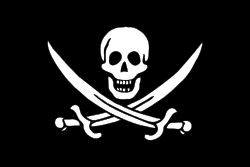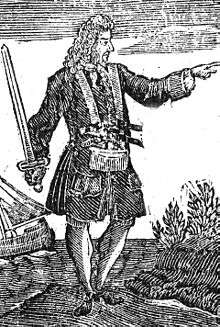Republic of Pirates
| Republic of Pirates | ||||||||||
| ||||||||||
 | ||||||||||
| Capital | Nassau | |||||||||
| Languages | English | |||||||||
| Religion | Puritan | |||||||||
| Government | 'Code of Conduct' | |||||||||
| Historical era | Age of Piracy | |||||||||
| • | Established | 1706 | ||||||||
| • | Disestablished | 1718 | ||||||||
| Area | ||||||||||
| • | 1718 | 13,878 km² (5,358 sq mi) | ||||||||
| ||||||||||
| Today part of | | |||||||||
The Republic of Pirates is the nomenclature for the base or stronghold run by privateers turned pirates in Nassau on New Providence island in the Bahamas for about eleven years from 1706 until 1718. Although not a state or republic in a formal sense, it was governed by its own informal 'Code of Conduct'. The activities of the pirates caused havoc with trade and shipping in the West Indies, until governor Woodes Rogers reached Nassau in 1718 and restored British control.
History
The era of piracy in the Bahamas began in 1696, when the privateer Henry Every brought his ship the Fancy loaded with loot from plundering Indian Empire trade ships into Nassau harbor. Every bribed the governor Nicholas Trott with gold and silver, and with the Fancy itself, still loaded with 50 tons of elephant tusks and 100 barrels of gunpowder. This established Nassau as a base where pirates could operate safely, although various governors regularly made a show of suppressing piracy. Although the governors were still legally in charge, the pirates became increasingly powerful.
The era of true pirate control occurred when a combined Franco-Spanish Fleet attacked Nassau in 1703 and again in 1706; the island was effectively abandoned by many of its settlers and left without any English government presence. Nassau was then taken over by English privateers, who became completely lawless pirates over time. The pirates attacked French and Spanish ships, while the French and Spanish forces burned Nassau several more times. Pirates established themselves in Nassau, and essentially established their own 'republic' with its own 'governors'. By 1713 the War of the Spanish Succession was over, but many British privateers were slow to get the news, or reluctant to accept it, and so slipped into piracy. This led to large numbers of unemployed privateers making their way to New Providence to join the 'republic' and swell its numbers. The 'republic' was dominated by two famous pirates who were bitter rivals – Benjamin Hornigold and Henry Jennings. Hornigold was mentor to pirates such as the infamous Edward Teach, known as "Blackbeard", along with Sam Bellamy and Stede Bonnet. Jennings was mentor to Charles Vane, 'Calico' Jack Rackham, Anne Bonny, and Mary Read. Despite their rivalries, the pirates formed themselves into the 'Flying Gang' and quickly became infamous for their exploits. The Governor of Bermuda stated that there were over 1000 pirates in Nassau at that time and that they outnumbered the mere hundred of inhabitants in the town. Blackbeard was later voted by the pirates of Nassau to be their 'Magistrate', to be in command of their 'Republic' and enforce law and order as he saw fit.
While originally the pirates had avoided attacking British ships, this restraint disappeared over time, and at their height, the pirates could command a small fleet of ships that could take on the frigates of the Royal Navy. The amount of havoc the pirates were causing led to an outcry for their destruction, and finally George I appointed Woodes Rogers as Governor of the Bahamas to bring the piracy to an end.[1] In 1718 Rogers arrived in Nassau with a fleet of seven ships, carrying a pardon for all those who turned themselves in and refrained from further piracy. Among those who accepted this offer was Benjamin Hornigold, and in a shrewd move, Rogers commissioned Hornigold to hunt down and capture those pirates who refused to surrender and accept the royal pardon. As a former privateer himself, Hornigold was well placed to understand what needed to be done and he pursued his former comrades with zeal. Although pirates such as Charles Vane and Blackbeard evaded capture, Hornigold did take ten pirates prisoner and on the morning of 12 December 1718, nine of them were executed. This act re-established British control and ended the pirates 'republic' in the Bahamas. Those pirates who had fled successfully continued their piratical activities elsewhere in the Caribbean in what has become known as the Golden Age of Piracy.
Code of Conduct
The pirates ran their affairs using what was called the Pirate code, which was the basis of their claim that their rule of New Providence constituted a kind of 'republic'. According to the code, the pirates ran their ships democratically, sharing plunder equally and selecting and deposing their captains by popular vote. Many of the pirates were privateers out of work since the end of the Queen Anne's War and ex-sailors who had revolted against the tyrannical conditions on merchant and naval ships, and Africans with many Irishmen could be equal members of the crew – several mulattos became pirate captains. Some of the pirates were also Jacobites, who had become pirates to help restore the recently deposed Stuart line to the throne.
Pirates of Nassau
See also
References
External links
- Republic of Pirates
- St. Augustine Pirate and Treasure Museum website
- Link to outline of Nassau history
- Article about the Bahamas and the Golden Age of Piracy
- Website on Pirate Code



